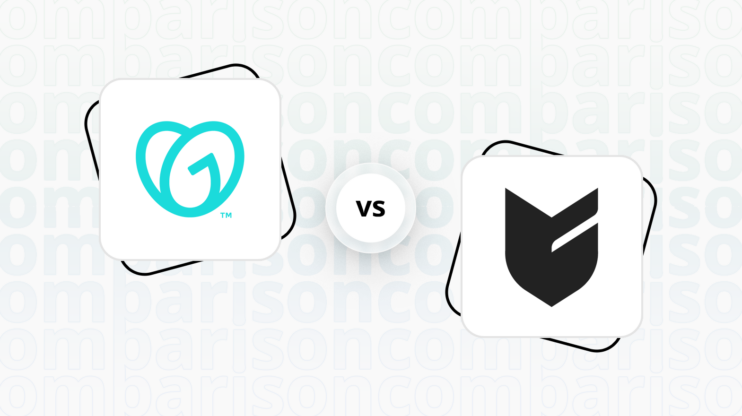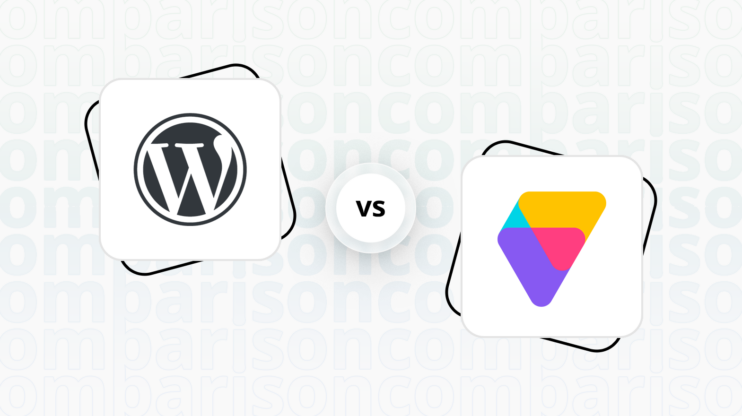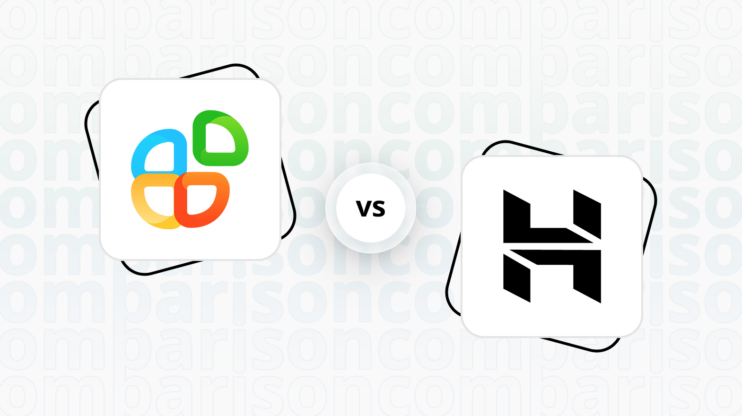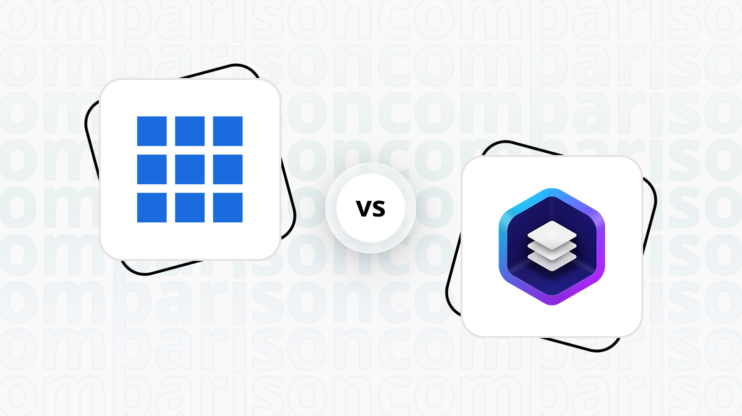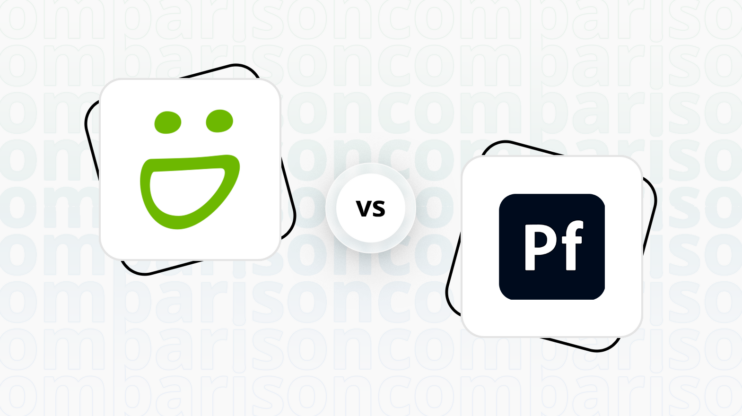Webflow vs Volusion: Final verdict
Webflow and Volusion both offer unique strengths, but they cater to different user needs and preferences.
-
Webflow (Overall Grade: 7.9/10)
excels in providing a robust design experience with extensive customization options and a powerful CMS. It is ideal for professional designers and developers who seek flexibility and control over their website’s design and functionality. Webflow’s intuitive visual interface, comprehensive learning resources, and strong hosting quality make it a top choice for creating custom, responsive websites. However, its ecommerce capabilities, while solid, may not be as comprehensive as those offered by dedicated ecommerce platforms. -
Volusion (Overall Grade: 6.6/10)
is a solid choice for small to medium-sized businesses looking for an all-in-one ecommerce solution. It offers a range of customizable templates, secure payment processing, and robust product management features. Volusion’s user-friendly interface and comprehensive inventory management system make it easy for businesses to build and manage their online stores. However, its limited design flexibility and occasional technical issues may be a drawback for users seeking more advanced features and customization options.

|

|
|
|---|---|---|
|
Design functionalities & templates |
8.6 |
6.1 |
|
Ease of use |
7.5 |
6.9 |
|
Ecommerce |
8.5 |
7.1 |
|
Website Editors |
9.0 |
7.1 |
|
Product testing options |
6.3 |
7.6 |
|
Price |
8.0 |
7.6 |
|
Hosting quality |
8.9 |
7.0 |
|
Website speed optimization |
8.1 |
7.1 |
|
Plugins and integrations |
5.5 |
6.8 |
|
Marketing features |
7.8 |
6.9 |
|
Customer support |
8.3 |
7.0 |
|
Security |
7.8 |
8.7 |
|
AI capabilities |
8.3 |
0.0 |
|
User Management |
8.3 |
7.7 |
Which one is the best for ecommerce: Webflow or Volusion?
 8.5
8.5
 7.1
7.1
Verdict
: Webflow is ideal for those who prioritize design flexibility and advanced customization, while Volusion is better suited for businesses that need robust inventory management and ease of use.
-
Webflow
: Known for its powerful design tools and flexible CMS, Webflow is perfect for businesses that want to create highly customized and responsive online stores. It integrates seamlessly with major payment gateways like Stripe and PayPal, making it a versatile choice for ecommerce. However, when comparing Webflow vs Volusion, Webflow might be more complex for beginners due to its extensive customization options. -
Volusion
: This platform offers a comprehensive product management system and a range of payment gateways, making it a solid choice for businesses that prioritize functionality and ease of use. Volusion’s templates are mobile responsive, and its low transaction fees are attractive for U.S.-based merchants. However, its bandwidth limitations could be a downside for high-traffic sites.
Which one is the best for informational and business websites?
 8.6
8.6
 7.2
7.2
Verdict
: When it comes to creating informational and business websites, Webflow takes the lead with its powerful design tools and flexible CMS, making it ideal for professional designers and businesses looking for a highly customizable platform. Volusion, while strong in ecommerce, is less suited for purely informational sites.
-
Webflow
: Webflow excels in providing a robust design experience with a diverse range of templates and customization options. Its intuitive visual interface and powerful CMS make it a top choice for creating custom, responsive websites without extensive coding knowledge. Scoring 8.6, Webflow is particularly well-suited for professional designers and businesses that need a high level of design flexibility and control. -
Volusion
: Volusion, scoring 7.2, is primarily an ecommerce solution, offering a range of customizable templates and tools for managing online stores. While it provides a user-friendly interface and comprehensive product management features, it may not be the best fit for purely informational websites. Volusion’s strengths lie in its ecommerce capabilities, making it more suitable for businesses looking to expand their online sales rather than focusing solely on informational content.
Webflow vs Volusion: Detailed comparison
Design functionalities & templates
Design FunctionalitiesRepresents how well each platform allows for creative design and customization of websites.Score Components:
- Template Variety (30%): Range and quality of design templates.
- Customization (30%): Flexibility and options for design alterations.
- User Interface (20%): Ease and intuitiveness of the design process.
- Responsiveness (10%): Adaptability to different devices and screen sizes.
- Innovation (10%): Unique design features and tools.
 8.6
8.6
 6.1
6.1
🏆
Winner: Webflow.
Webflow offers a more robust design experience with a diverse range of template and customization options.
Webflow delivers a robust design experience with a diverse range of template and customization options. Boasting over 1000 pre-built templates covering various industries and website types, including free and premium options, Webflow ensures a constantly evolving library for users.
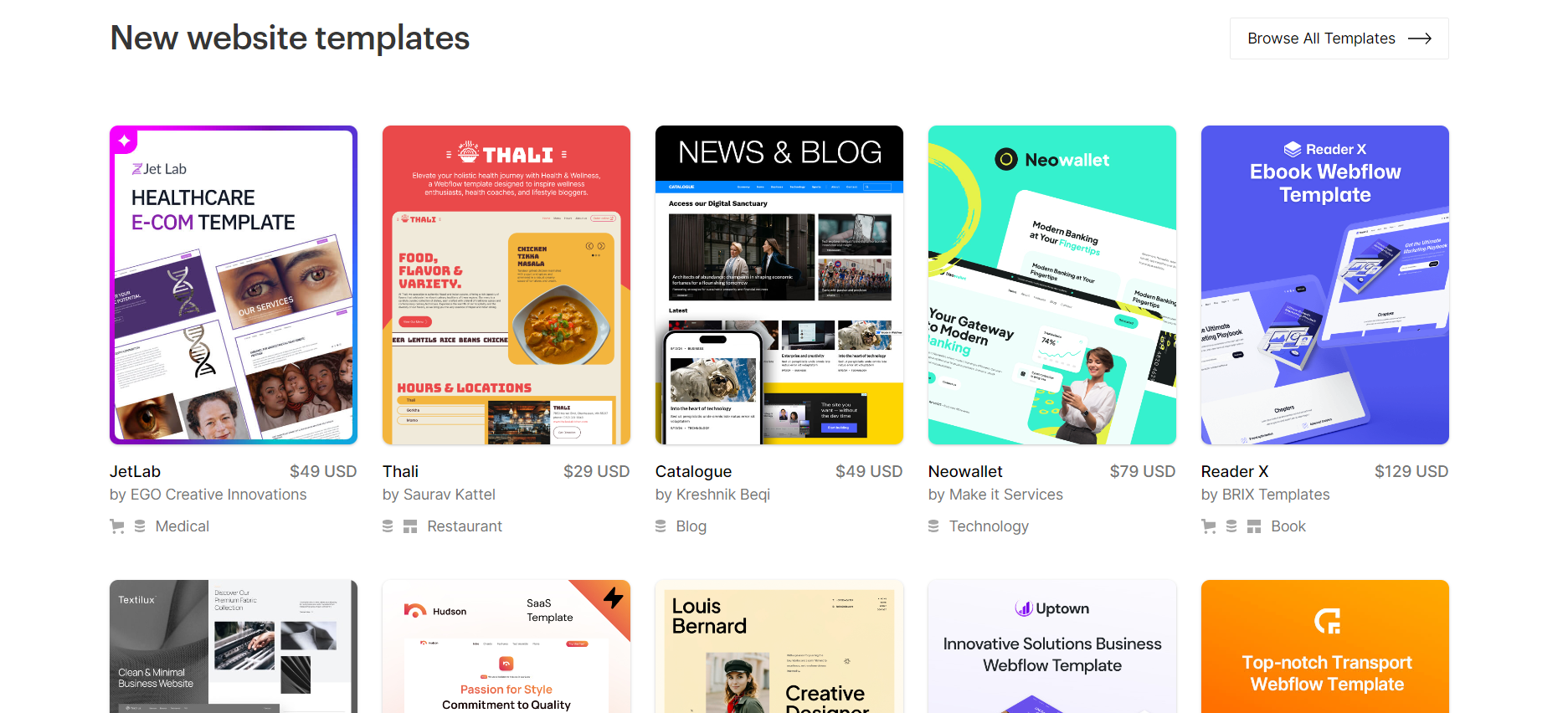
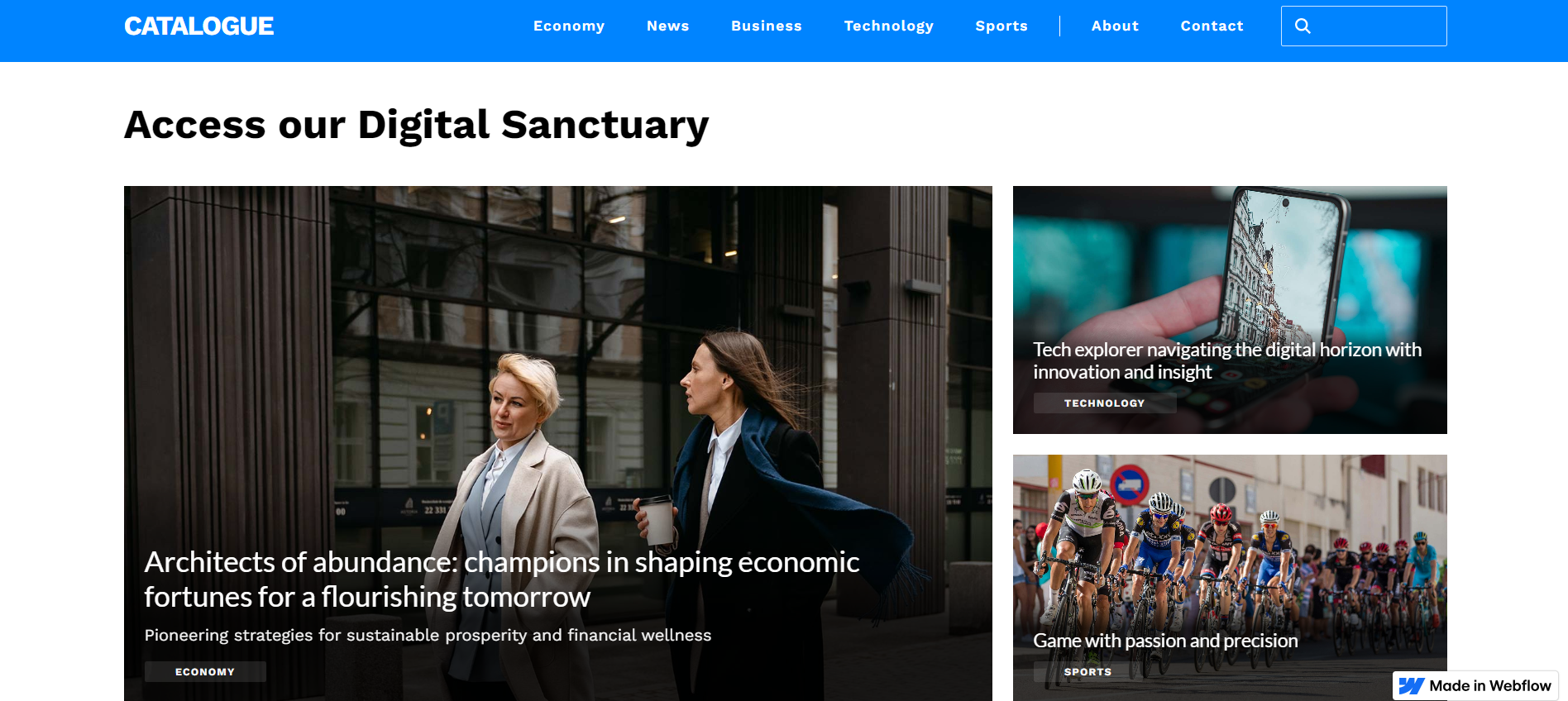
On the other hand, Volusion, as a website builder, offers a variety of design templates tailored to meet the diverse needs of online stores and businesses. The platform provides users with over 30 professionally designed, responsive templates.
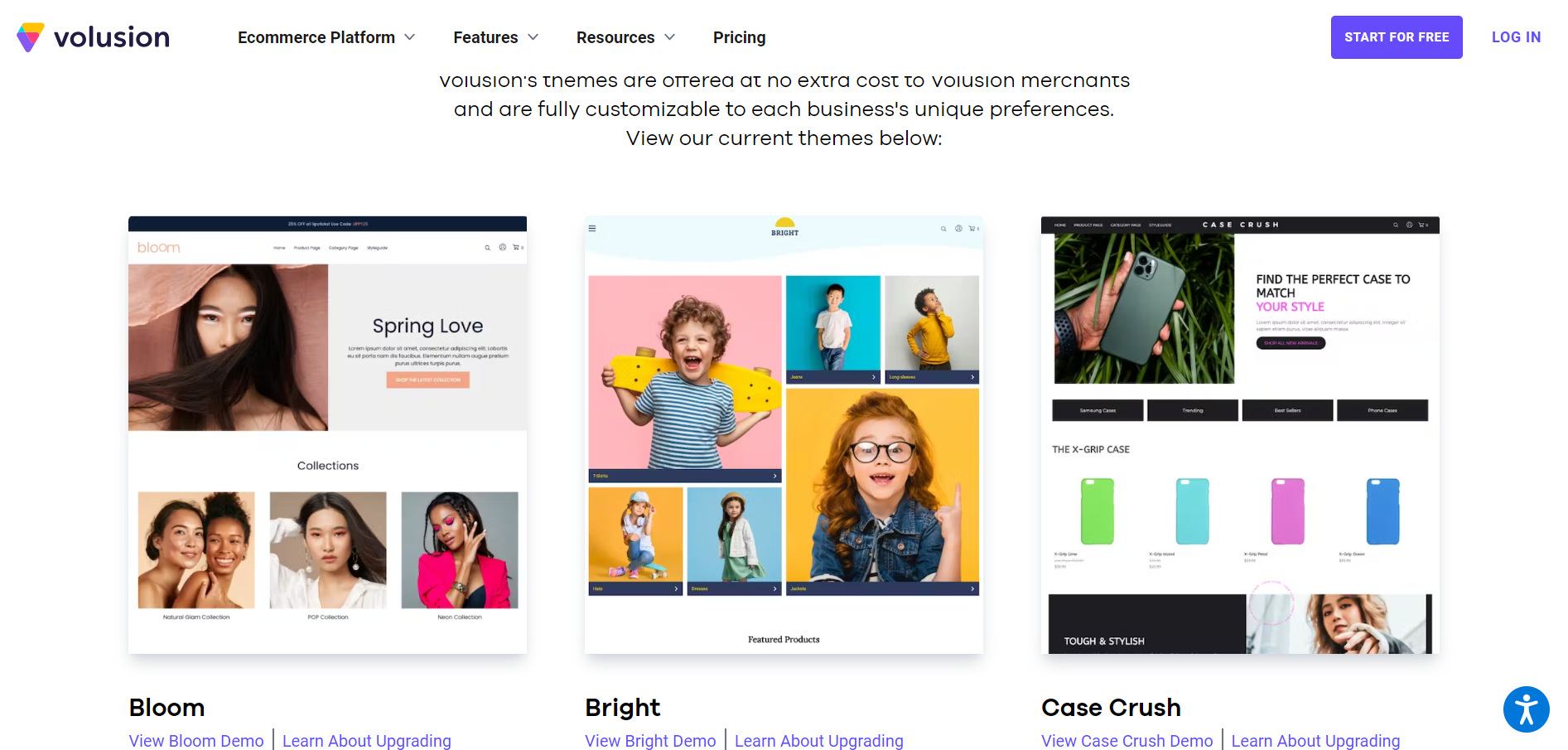
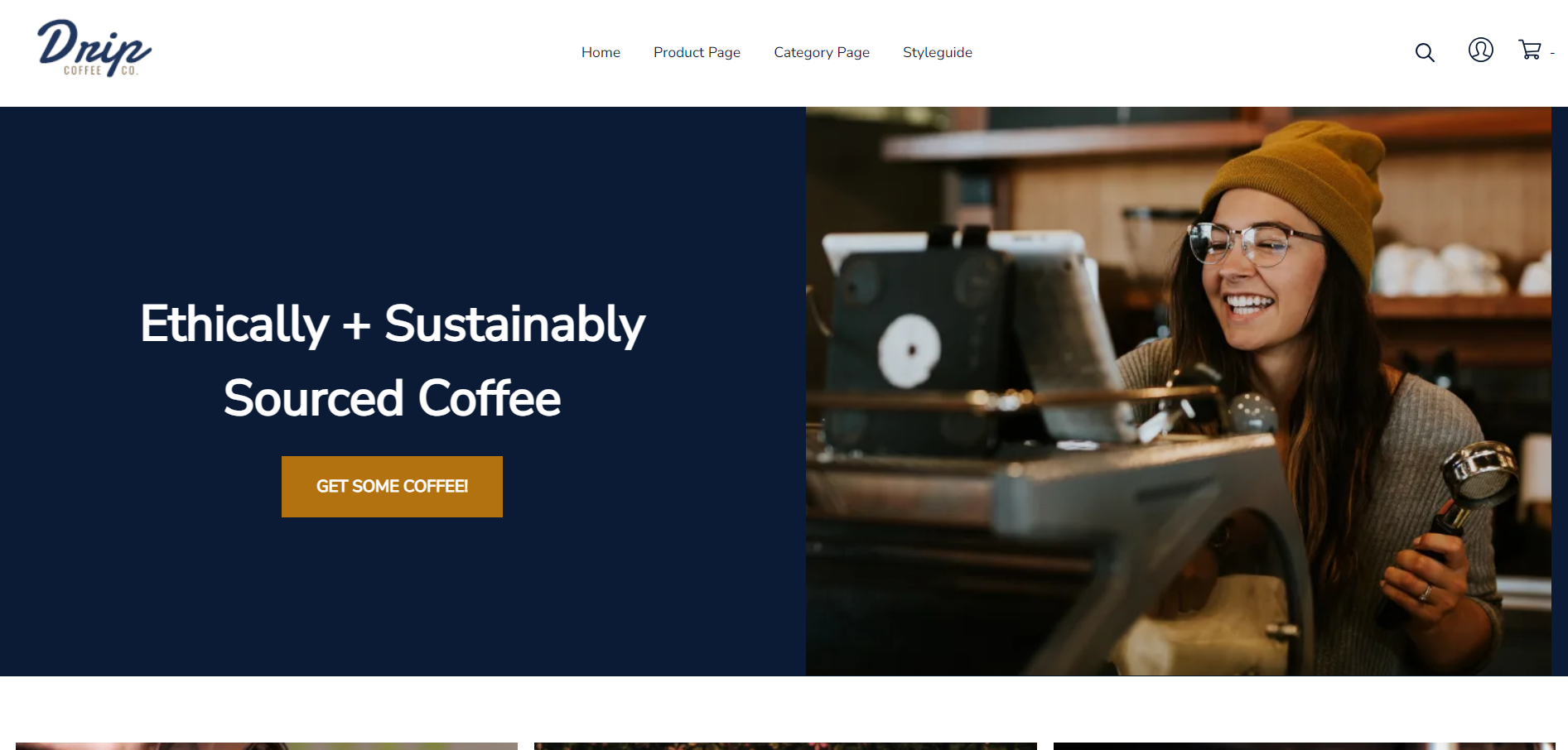
Get a head start on website creation with AI
Create a custom website tailored to your business needs 10X faster with 10Web AI Website Builder!
Ease of use
Ease of useReflects the platform’s overall user-friendliness.Score
Components:
- Learning curve (40%): Quickness and ease of getting started.
- Interface design (30%): Simplicity and intuitiveness of layout.
- User guidance (20%): Quality of tutorials and support.
- Flexibility (10%): Adaptability to various user skills.
 7.5
7.5
 6.9
6.9
🏆 Winner: Webflow
. Scoring 7.5, Webflow is slightly easier to use than Volusion, which scores 6.9. Webflow offers a visually intuitive interface with drag-and-drop features, making it user-friendly for experienced designers and developers. On the other hand, Volusion provides a user-friendly interface that caters to both beginners and experienced users, but some users may find the platform’s features and tools less intuitive compared to leading competitors.
Learning Resources
🏆 Winner: Webflow
. Both platforms offer comprehensive learning resources, but Webflow stands out with its diverse courses and tutorials, active community forums, and a range of video content on its YouTube Channel.
For ecommerce
EcommerceMeasures the platform’s effectiveness in supporting online business activities.Score Components:
- Ecommerce themes and templates (20%): Variety and design of templates.
- Product management (25%): Ease of managing and organizing products.
- Payment options (25%): Variety and convenience of payment methods.
- Ecommerce features (20%): Features for managing an ecommerce store.
- Integration (10%): Compatibility with external e-commerce tools and services.
 8.5
8.5
 7.1
7.1
Webflow and Volusion are both robust platforms for ecommerce, but they cater to different needs and preferences. Webflow stands out with its extensive customization options and integration with major payment gateways, making it a flexible choice for businesses that value design freedom and versatility. On the other hand, Volusion offers a comprehensive inventory management system and a range of payment gateways, making it a solid choice for businesses that prioritize functionality and ease of use. However, Volusion’s bandwidth limitations could be a downside for high-traffic sites.

|

|
|
|---|---|---|
|
Ecommerce themes and templates |
7.5 |
6.5 |
|
Product page customization |
8.3 |
7.0 |
|
Payment processing and commissions |
7.8 |
7.5 |
|
POS capabilities |
6.5 |
7.0 |
|
Payment gateways |
8.0 |
7.5 |
|
Product numbers |
7.0 |
6.0 |
|
Additional ecommerce features |
7.9 |
7.0 |
Webflow ecommerce features:
- Checkout and Payment Processing with Stripe, PayPal, etc.
- Marketing and Promotions
- Tax and Shipping calculations
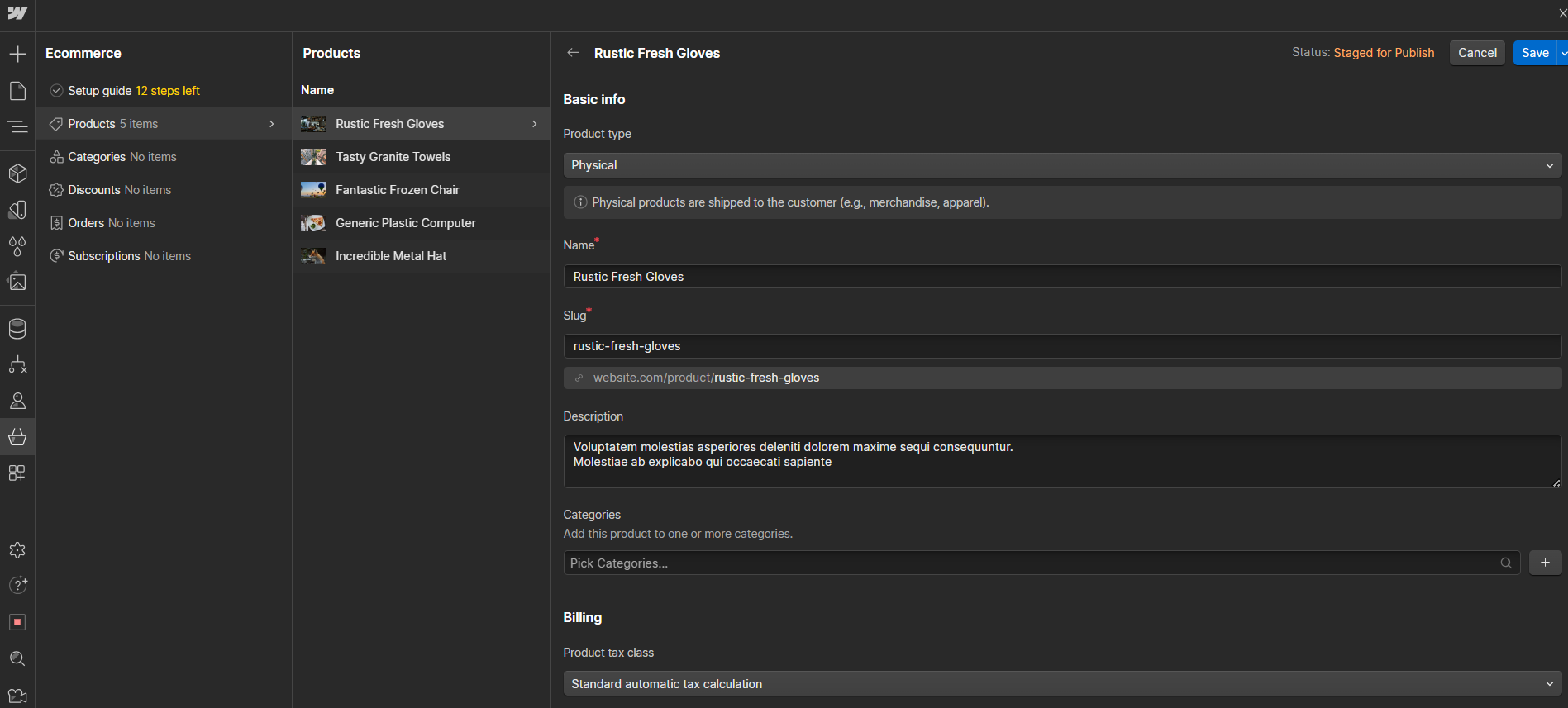
Volusion ecommerce features:
- Ecommerce Product listings
- Payment Gateways
- Multiple Currencies support
- Shipping options
- SEO tools
- Social Media Integration
Ecommerce themes & templates
Webflow offers a diverse range of ecommerce themes and templates designed to cater to various types of online stores. Each template comes equipped with built-in ecommerce functionality, allowing you to easily add products and manage your store without the need for coding. On the other hand, Volusion offers a selection of ecommerce-specific templates designed to cater to various store aesthetics and needs. They provide 14 free themes and 38 paid themes, each costing $180. These templates are mobile responsive, ensuring that your online store is accessible and user-friendly across all devices.
Product page customization
Webflow offers extensive customization options for eCommerce product pages, allowing users to design and personalize their pages without coding. It provides tutorials for creating product pages from scratch, offers responsive templates for various devices, and allows users to add custom code and dynamic content using Webflow’s CMS for maximum customization flexibility. Volusion, on the other hand, offers a range of ecommerce product page customization options to enhance the shopping experience. Users can modify product descriptions, images, and videos to showcase their items effectively. The platform allows for the customization of options and variants, such as size and color, to provide a more detailed and user-friendly product selection process.
Payment processing
When it comes to payment processing, Webflow provides a flexible and secure platform for payment processing and ecommerce through integrations with leading payment gateways like Stripe and PayPal. This allows users to accept a wide range of payments, including credit card transactions directly from their websites. Volusion offers a comprehensive eCommerce platform that supports various payment gateways, including PayPal, Stripe, and its own solution, Volusion Payments, tailored for U.S.-based merchants. The platform is distinctive for its low transaction fees, which vary based on the subscription plan. Additionally, Volusion provides POS capabilities, enabling seamless sales both online and in physical locations.
Website Editors
Website EditorsEvaluates the platforms’ website building and editing capabilities.Score Components:
- Customization tools (40%): Range and power of editing features.
- Editor usability (30%): User experience within the editor.
- Design flexibility (20%): Freedom in layout and design changes.
- Update and maintenance ease (10%): Simplicity of updating and maintaining the site.
 9.0
9.0
 7.1
7.1
🏆
Winner: Webflow
. With a score of 9.0, Webflow’s editor is praised for its intuitive visual interface that simplifies the process of designing and editing responsive websites without requiring deep technical knowledge. It offers a perfect blend of ease of use for beginners and the flexibility for more advanced users, enabling significant cost savings by allowing users to customize and manage their sites without hiring professionals.
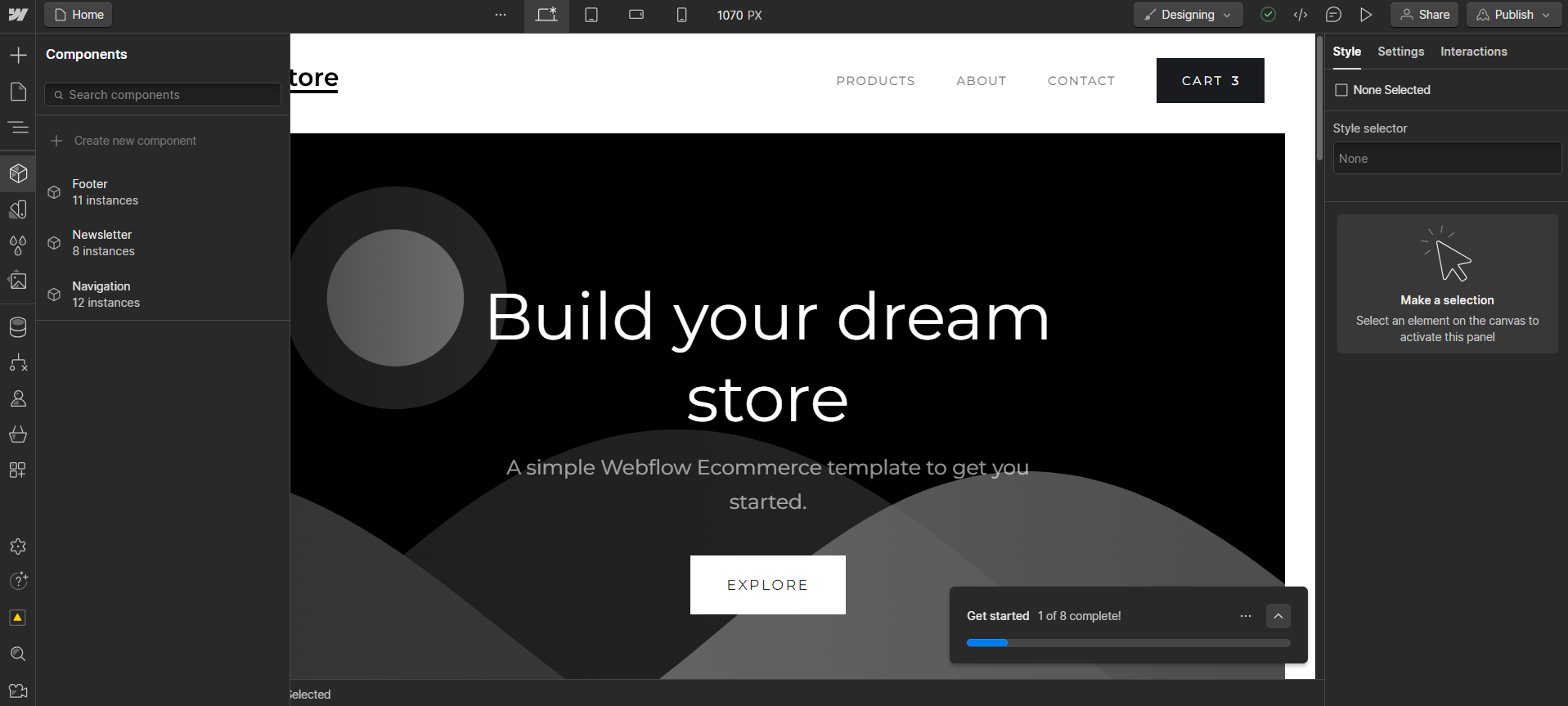
Volusion’s editor, scoring 7.1, is designed for ease of use, catering to both beginners and experienced users. It offers a drag-and-drop interface, allowing users to easily add, remove, or modify elements on their website without needing to code. However, beginners might encounter some difficulties due to its depth of features and customization options, which can be overwhelming without prior experience in website building.
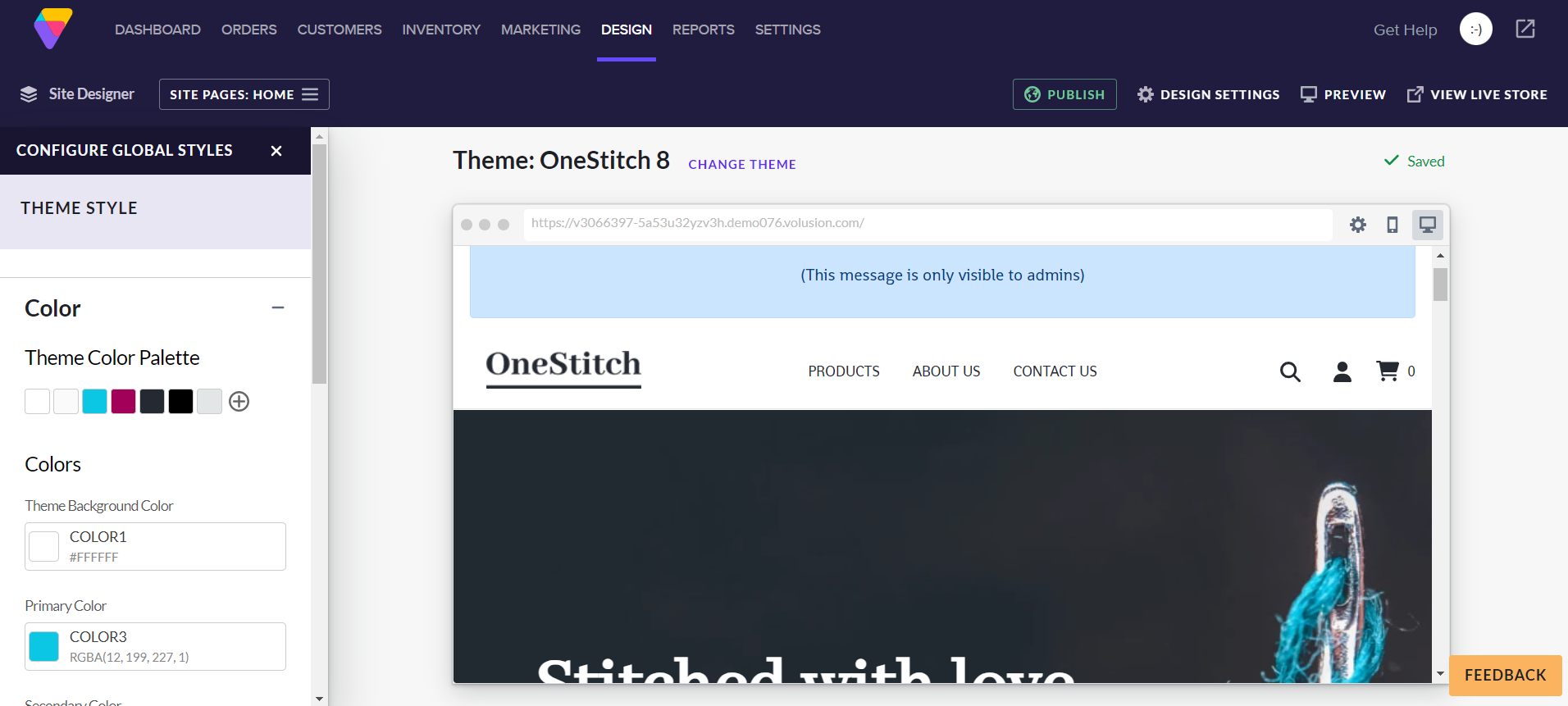
Mobile editor/app
 7.0
7.0
 4.5
4.5
🏆
Winner: Webflow
. Both Webflow and Volusion do not have official mobile editor apps. However, Webflow has a third-party app called EditFlow, created by a community member for Webflow users, which is currently only available for iOS. This gives Webflow an edge over Volusion, which does not have a dedicated mobile editor app. Editing on a mobile browser is possible with Volusion, but the experience might not be optimal due to the smaller screen size, and navigating through the admin dashboard could be difficult. Therefore, Webflow scores higher in the mobile editor category.
Product testing options
Product Testing OptionsAssesses the options for trying out platform features before commitment.Score Components:
- Trial quality (40%): Extent and usefulness of the trial or free version.
- Feature accessibility (30%): How many features are available to test.
- Trial duration (20%): Length of the trial period.
- Ease of transition (10%): Smoothness of moving from trial to paid plans.
 6.3
6.3
 7.6
7.6
Overall Result
:
Volusion wins
. Volusion scores 7.6, higher than Webflow’s 6.3, in product testing options. Volusion offers a 14-day free trial during which users can test premium features. However, it does not offer a money-back guarantee. On the other hand, Webflow offers a free version with basic features but does not provide a trial version or a money-back guarantee.

|

|
|
|---|---|---|
|
Free Plan |
Yes |
No |
|
Trial Duration |
No |
14 days |
|
Testing Premium Features |
Basic features with free plan |
Premium features during free trial |
|
Money Back Guarantee |
No | No |
Price
PriceLooks at the cost-effectiveness and value for money of each platform.Score Components:
- Plan value (40%): What each pricing tier offers.
- Transparency and clarity (30%): Clearness of pricing structures.
- Flexibility of plans (20%): Range of options to suit different budgets.
- Hidden costs (10%): Additional expenses not included in the plan.
 8.0
8.0
 7.6
7.6
Webflow and Volusion both offer a range of pricing options to suit different needs, with Webflow scoring slightly higher in terms of price.

|

|
|
|---|---|---|
|
Free |
Starter (Free): Limited features for new sites, including 2 static pages and 50 form submissions lifetime. |
No offering at this amount. |
|
$10-$20 |
Basic ($18/month): Suitable for simple sites with a custom domain, including basic SEO controls and 500 monthly form submissions. And 100 pages. Value for price: 6.5 |
No offering at this amount. |
|
$20-$30 |
CMS ($29/month): For content-driven sites with 2,000 CMS items, 1,000 monthly form submissions, and full API access. And 150 website pages. Value for price: 7.5 |
No offering at this amount. |
|
$30-$45 |
Standard ($42/month): For new businesses with up to 500 ecommerce items, includes basic ecommerce features, and 2% transaction fee Value for price: 8.5 |
Personal ($35/month): Suitable for small businesses, allowing up to 100 products, 1 staff account, and offers support via live chat and email. Supports stores with up to $50K in GMV/year. This plan allows to manage 1 website and there is no limitation of number of pages offered. Value for price: 6.5 |
|
$45-$50 |
Business ($49/month): High traffic capacity, advanced features like site search, and up to 10 content editors. Value for price: 8.0 |
No offering at this amount. |
|
$70-$90 |
Plus ($84/month): Higher volume businesses with 0% transaction fees, up to 5,000 ecommerce items, and advanced features. Value for price: 9.0 |
Professional ($79/month): Targets growing businesses with up to 5,000 products, 5 staff accounts, and additional features like newsletters, abandoned cart reports, and phone orders. Supports up to $100K in GMV/year. This plan allows to manage 1 website and there is no limitation of number of pages offered. Value for price: 7.5 |
|
$200+ |
Advanced ($235/month): Scalable solution for large online stores with up to 15,000 ecommerce items and the highest caps and 0% transaction fees. Value for price: 9.5 |
Business ($299/month): Designed for large stores, offering unlimited products, 15 staff accounts, priority support, and integrations with Amazon and eBay. Supports stores with up to $500K in GMV/year. This plan allows to manage 1 website and there is no limitation of number of pages offered. Value for Price: 8.0 |
location. As a result in rare cases the prices displayed here can differ from the ones you see on their
websites.
Hosting quality
Hosting
qualityExamines the reliability and performance of the hosting solutions.Score Components:
- Uptime (40%): Consistency and reliability of website availability.
- Speed (30%): Loading times and performance.
- Bandwidth and storage (20%): Sufficiency of resources provided.
- Data centers (10%): Quality and distribution of hosting infrastructure.
 8.9
8.9
 7.0
7.0
Winner: Webflow
. Webflow offers managed hosting with a 99.99% uptime guarantee on its Enterprise plan. It leverages a globally distributed network of data centers from Amazon Web Services (AWS) and Fastly, ensuring good performance and response times. Volusion, on the other hand, offers managed cloud hosting with a 99.9% uptime guarantee, but does not publicly disclose any information about their data centers.

|

|
|
|---|---|---|
|
Do they offer hosting? |
Yes, included in all paid plans |
Yes, included in all paid plans |
|
Data Centers: |
Webflow doesn’t actually have its own data centers. Instead, it relies on a globally distributed network of data centers from Amazon Web Services (AWS) and Fastly |
Volusion does not publicly disclose any information about their data centers |
|
Type of hosting: |
Managed Hosting |
Managed Cloud Hosting |
|
Uptime: |
99.99% |
99.9% |
|
Uptime Guarantee: |
Only Enterprise plan, 99.99% |
Yes, 99.9% |
Website Speed Optimization
Website Speed OptimizationEvaluates optimization of website loading timesScore Components:
- PageSpeed Score (30%): Google’s score indicating performance optimization.
- Loading Time (30%): The average time until a website is fully interactive.
- Mobile Optimization (15%): Optimization effectiveness for mobile devices.
- Resource Optimization (15%): Optimizing images, scripts, and other heavy resources.
- CDN Usage (10%): Use of CDN to enhance speed across geolocations.
 8.1
8.1
 7.1
7.1
🏆 Winner: Webflow
Both Webflow and Volusion prioritize website performance and page speed, but Webflow’s strategies and performance metrics give it an edge over Volusion.

|

|
|
|---|---|---|
|
Focus |
Custom Cache Settings, Custom Element Lazy Loading, Automatic Minification, Responsive templates, CDN |
CDN, Image optimization, Code minification, Regular Monitoring and Updates, SEO optimization |
|
Performance Tools |
Google Lighthouse, PageSpeed Insights |
Google PageSpeed Insights, Regular Monitoring and Updates |
|
Key Strategies |
Custom Cache Settings, Custom Element Lazy Loading, Automatic Minification, Responsive templates, CDN |
CDN, Image optimization, Code minification, Regular Monitoring and Updates, SEO optimization |
|
Load Times |
Below 2 seconds average |
Varies widely, depending on the optimization, website complexity |
|
Page Speed Scores Range |
77.2/100 |
Varies widely, depending on the optimization, website complexity |
|
Core Web Vitals Improvement |
Improving components’ usability, and emphasis on LCP, FID and CLS |
Implementing various performance optimization techniques |
Webflow’s approach to enhancing site speed includes custom cache settings, custom element lazy loading, automatic minification, responsive templates, and a content delivery network (CDN). These strategies, combined with an average load time of below 2 seconds and a PageSpeed score of 77.2/100, make Webflow a strong contender in terms of website speed optimization. Webflow also focuses on improving components’ usability and emphasizes on Largest Contentful Paint (LCP), First Input Delay (FID), and Cumulative Layout Shift (CLS) for Core Web Vitals improvement.
On the other hand, Volusion’s strategies for speed optimization include CDN, image optimization, code minification, regular monitoring and updates, and SEO optimization. However, both its load times and PageSpeed scores vary widely, depending on the optimization and website complexity. For Core Web Vitals improvement, Volusion implements various performance optimization techniques.
Get a head start on website creation with AI
Create a custom website tailored to your business needs 10X faster with 10Web AI Website Builder!
Plugins and integrations
Plugins and integrationsMeasures the range and effectiveness of additional plugins and integrations.Score Components:
- Variety of options (40%): Range of available add-ons.
- Integration smoothness (30%): Ease of integrating plugins into the site.
- Quality of plugins (20%): Functionality and reliability of the options.
- Custom integration capabilities (10%): Support for custom or third-party integrations.
 5.5
5.5
 6.8
6.8
🏆 Winner: Volusion.
With a score of 6.8, Volusion offers a marketplace with a variety of integrations to enhance its ecommerce platform. It includes tools and services across categories such as Accounting, Business Resources, Channel Management, Customer & Relationship Management, Design, Domain Registration, Email Marketing, Fulfillment, International, Live Chat, Marketing, Mobile, Order Management, Payment Processing, Security, Shipping, and Shopping Feeds. In total, there are 82 integrations available to help complete your ecommerce business needs.
Webflow, scoring 5.5, doesn’t have plugins or extensions in the traditional sense. Instead, it offers a built-in library of website elements and functionalities that you can use to create your website. This library is constantly being expanded, so you’ll always have access to the latest features and tools. However, Webflow does integrate with a number of third-party services and tools that can add even more functionality to your website. These integrations are not managed by Webflow, so the number of available options and their pricing structures can vary depending on the specific tools you choose.
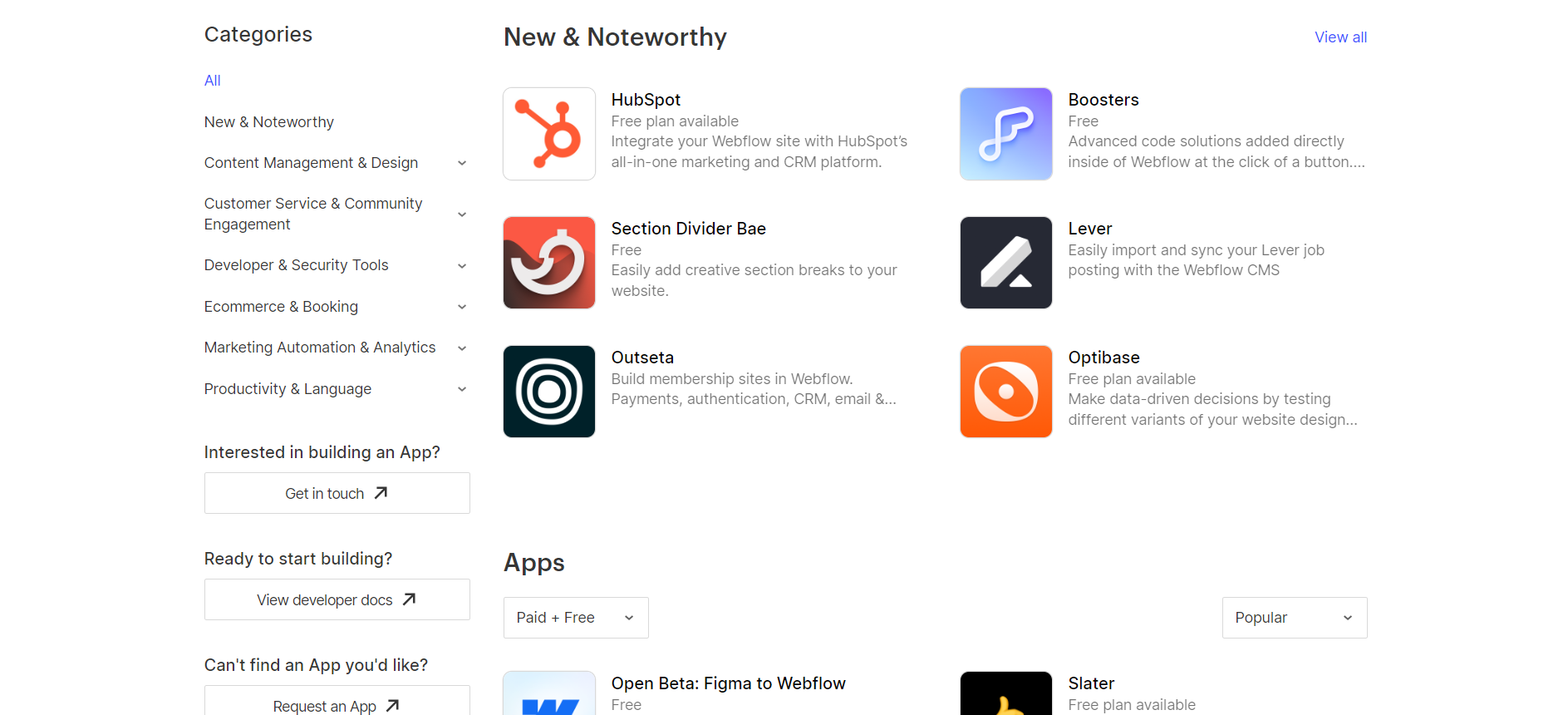
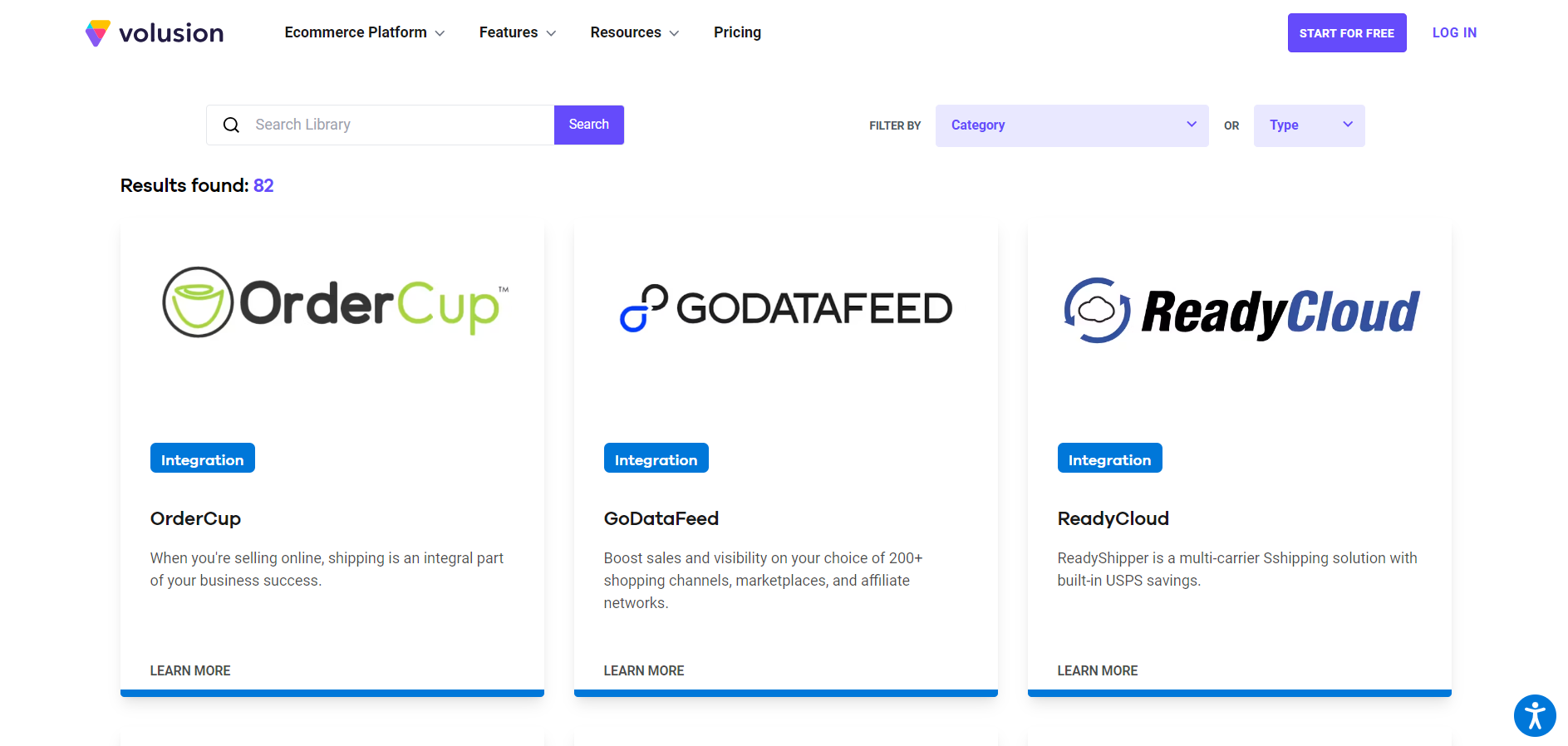
Marketing Features
Design FunctionalitiesRepresents how well each platform allows for creative design and customization of websites.Score Components:
- Template Variety (30%): Range and quality of design templates.
- Customization (30%): Flexibility and options for design alterations.
- User Interface (20%): Ease and intuitiveness of the design process.
- Responsiveness (10%): Adaptability to different devices and screen sizes.
- Innovation (10%): Unique design features and tools.
 7.8
7.8
 6.9
6.9
🏆
Overall Winner: Webflow
. Webflow stands out for its comprehensive marketing tools, especially in analytics and ad campaign management. Volusion, while strong in SEO and social media integration, lacks blogging capabilities.

|

|
|
|---|---|---|
|
SEO Tools |
|
|
|
Email Marketing |
|
|
|
Blogging |
|
|
|
Social Media Integration |
Simplifies content sharing and audience engagement on major social platforms |
Yes, with direct selling on platforms |
|
Analytics and Reporting |
Integrates with Google Analytics for comprehensive web traffic and behavior analysis |
Yes, with Google Analytics integration and custom reporting |
|
Ads and Promotions |
Supports ad and promotion management through integration with platforms like Google Optimize |
Yes, but limited |
Customer Support
Customer supportEvaluates the quality and availability of support options.Score Components:
- Response time (40%): Speed of support responses.
- Support quality (30%): Effectiveness and helpfulness of the support.
- Availability (20%): Range of support channels (phone, chat, email).
- Resource richness (10%): Quality of self-help and educational materials.
 8.3
8.3
 7.0
7.0
🏆 Winner: Webflow
. Comparing Webflow vs Volusion, Webflow takes the lead in this category with its 24/7 customer support through live chat, email, and a community forum. Webflow also offers extensive documentation and video tutorials, making it easier for users to find solutions to their problems quickly. The availability of a dedicated Customer Success Manager for enterprise clients further enhances the support experience.
Volusion, on the other hand, provides customer support via phone during business hours and 24/7 chat support through the Merchant Center dashboard. While Volusion’s support is commendable, especially for enterprise clients with a dedicated client success manager, it falls short of Webflow’s round-the-clock availability and comprehensive support resources.
Security
SecurityLooks at the platforms’ security measures and data protection.Score Components:
- Data protection (40%): Safeguards for user and customer data.
- SSL and encryption (30%): Implementation of secure connections.
- Compliance (20%): Adherence to industry security standards.
- Regular updates (10%): Frequency of security updates and patches.
 7.8
7.8
 8.7
8.7
🏆
Winner: Volusion
. Volusion takes the lead in security with a score of 8.7, compared to Webflow’s 7.8. Volusion’s comprehensive security measures, including robust data encryption, two-factor authentication, SSL certificates, PCI DSS compliance, and regular security audits, provide a secure environment for ecommerce businesses.
Webflow, while offering robust security measures such as SSL encryption, regular security audits, and two-factor authentication, falls slightly short in comparison to Volusion’s specialized ecommerce security features.
AI Capabilities
AI capabilitiesMeasures the effectiveness of AI-driven features and tools.Score Components:
- Automation efficiency (40%): Impact of AI on streamlining processes.
- Personalization (30%): AI-driven customization for users or customers.
- AI-Assisted design (20%): Role of AI in website design and functionality.
- Data analysis (10%): Use of AI in interpreting user data and analytics.
 8.3
8.3
 0.0
0.0

|

|
|
|---|---|---|
|
AI Builder |
Announced, but not yet available |
Not available |
|
AI Ecommerce Features |
Not available |
Not available |
|
AI Content Generation |
Announced, but not yet available |
Not available |
|
Additional AI Features |
Announced, but not yet available |
Not available |
🏆 Winner: Webflow
. Although neither Webflow nor Volusion currently offer AI capabilities, Webflow has announced plans to introduce AI features in the near future. These include AI-powered design suggestions, content management, and website creation tools. On the other hand, Volusion does not have any AI capabilities and has not announced any plans to introduce such features.
User Management
User ManagementAssesses the platforms’ capabilities in managing user roles, permissions, and accessibility.Score Components:
- Role Customization (40%): Flexibility in creating and defining user roles and
permissions. - Ease of Management (30%): User interface and tools for managing users.
- Access Control (20%): Effectiveness of access control measures for different user
levels. - Scalability (10%): Ability to manage a growing number of users efficiently.
 8.3
8.3
 7.7
7.7
🏆 Winner: Webflow
. Both Webflow and Volusion offer different approaches to user management, but Webflow scores slightly higher.
- Webflow’s user management varies by plan, with Core, Growth, and Enterprise plans offering unlimited editors. Access levels include Designer for full access and Editor for content editing. Workspace roles like Admin, Designer, and Editor ensure collaboration and security through features like the Site Activity Log and role-based permissions.
- Volusion offers customizable user account management with various roles and permissions tailored for efficient online store operation. Subscription plans determine the number of staff accounts available: 1 in the Personal Plan, 5 in the Professional Plan, 15 in the Business Plan, and unlimited in the Prime Plan.
Webflow User Roles and Access Levels:
| Role | Description | Access Highlights |
|---|---|---|
| Workspace Owner | Full control over Workspace settings and member management. | Edit settings, manage billing, access/edit all sites, invite/remove members, manage permissions. |
| Workspace Admin | Similar to the owner with some restrictions. | Edit settings, manage billing, access/edit all sites, invite/remove members (except owner), manage permissions. |
| Workspace Member | Limited control focused on site interaction. | Download invoices, access/edit sites, invite members. |
| Workspace Guest | Temporary collaborators with limited access. | Access/edit sites. |
| Workspace Commenter | Limited to commenting for feedback on sites. | Create/view/resolve comments, preview sites. |
| Site Admin | Full control at the site level. | Manage permissions, delete/transfer sites, billing management, design and publish changes. |
| Can Design | Design capabilities with some restrictions on publishing. | Design in Designer, create/modify classes and components, publish changes with permission. |
| Can Design (Limited) | Restricted design capabilities for Enterprise customers. | Create new classes, modify created classes, limited publishing capabilities. |
| Can Edit | Content editing without full design privileges. | Edit text/links/images, manage assets, publish Collection items and Ecommerce products. |
| Can Comment (Site Level) | Commenting for feedback at the site level. | Create/view/resolve comments, preview sites. |
Additional Features

|

|
|
|---|---|---|
|
SSL Certificate |
|
|
|
Custom Domain |
|
|
|
Free Custom Domain Included |
|
|
|
International Domains |
|
|
|
Mobile Responsive |
|
|
|
Page Speed |
|
|
|
Website Builder Mobile App |
|
|
|
Convert a Website To An App |
|
|
|
Website Analytics |
|
|
|
Multilingual Sites |
|
|
|
Multiple Users |
|
|
Webflow vs Volusion: User Feedback
Webflow receives high praise for its user-friendly interface, eliminating the need for coding while offering extensive design flexibility. Users appreciate its scalability, cost-effectiveness, and seamless integration of essential features like forms and CMS. However, some users note a slight learning curve and occasional limitations, particularly in ecommerce functionalities and content management. Overall, Webflow proves to be a powerful tool for building and managing websites, offering robust features for both beginners and experienced developers, albeit with some room for improvement in certain areas like collaborative editing and content management.
Users generally appreciate Volusion’s affordability compared to competitors like Shopify, finding its simplified user interface suitable for non-tech users. However, there are concerns about its limited integrations and frequent technical issues, such as crashes and slow support responses. Some users feel that Volusion lacks the advanced features and customization options offered by competitors like Shopify, making it less competitive in the market. Despite these drawbacks, Volusion remains a feasible option for small to medium-sized businesses seeking a budget-friendly solution for establishing an online store.
The making of this blog
We followed a clear, step-by-step process to write and research this article.
Webflow vs Volusion: FAQ
Which platform is better for ecommerce, Webflow or Volusion?
Can I build an informational or business website with Webflow and Volusion?
How do Webflow and Volusion compare in terms of design and customization?
Which platform is easier to use, Webflow or Volusion?
How do Webflow and Volusion handle hosting and website speed optimization?
Which platform offers better customer support, Webflow or Volusion?
Are there any AI capabilities in Webflow or Volusion?










